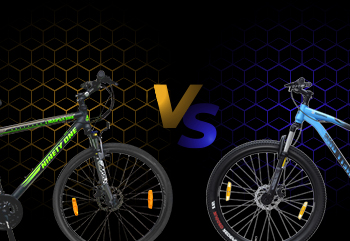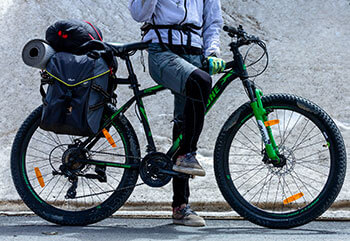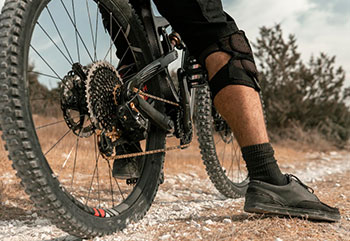A Detailed Guide On Cycle Gears

As it is well-known, a bicycle is a collection of components that have come together to form a beautiful machine that's a favourite among many. A bike can be used for numerous things; it's a great form of commuting and leisure riding, it's great for adventurous off-roading, and it's fantastic exercise as well. We've all heard of terms like a suspension fork, brakes, handlebars, frames, and so many more. These can be confusing, especially for a beginner or for someone who wants to purchase a new bike. We've also heard terms like single-speed, and multi-speed (or gear wali cycle) being thrown around here and there, and this can be mind-boggling. However, speeds generally refer to the gears on the bikes. Today, we are demystifying cycle gears to better understand the technicalities of bicycles.

What are cycle gears?
Gears are components that help us ride faster. This speed is required on inclines when we want our rigorous and strenuous pedalling to be converted to higher speeds. The higher the gear, the quicker our bike will be. Gears are helpful because there is all so much cadence with which we can ride. One has to rely on these gears to increase the speed. One also needs to have a good understanding of the terrain; this helps us change the gears efficiently. Most mountain bikes come with a lot of gears as these bikes are driven on rugged terrains, which vary in nature from time to time.
Just like bikes, there are a few types of cycle gear systems as well. Let's go over them:
- Bicycle External Drivetrains: Most bikes these days have external drivetrain systems. These external drivetrains are lightweight and efficient as well. A cassette is a set of sprockets situated on the rear wheel; a cassette is a location where the gears are changed. The gears are changed by the rear derailleur on the cassette. The derailleur moves the chain onto bigger or smaller sprockets as the gears are changed. Specific bikes also have a front derailleur, a front derailleur shifts the chain between the chainrings. The gears at the front give you better jumps, while the cassette allows you to select the gears efficiently. A bike can have up to three chainrings as well as eleven sprockets. However, specific specialized bikes can have more. The Snow Leopard 26T by Ninety One Cycles comes with 21-speed Shimano shifter gears, which allows for smooth gear shifting and a supreme performance on all terrains making it one of the best gear cycles.
- Hub gears: These gears are also popular. However, they are far more common in commuters and road bikes. This cycle gear system gives a maintenance-free and robust drivetrain to the rider. Most hub gears are packaged inside the rear wheels which makes them less susceptible to damage. This also protects them from the winters. There are various hub gears available in the market. Some of the popular ones are Shimano, SRAM, Sturmey Archer, and even Rohloff. One of the significant drawbacks of a hub gear can be the weight.

While these are the two significant types of cycle gear systems available, you must have definitely heard about the single-speed or fixed bike as well. When bikes initially started out, there was the option of only one speed. Single-speed cycles use only a single cog and allow the rear wheel to rotate without the assistance of the pedal. Fixed bikes are even more rigid and fundamental in their build, and the rear cog is fixed into place. One of the significant benefits of a single-speed bicycle is its low maintenance and cost-effectiveness.
Let's now understand a few more essential facts about the gear systems on a bicycle:
- There is a term called gear inches; the number of inches a bike moves with each pedal stroke or gear development is referred to as gear inches. The number of inches a bike rolls forward with each crank rotation is referred to as gear inches. Gear inches give you a good measure of the intensity of the gears. Ranges of 20 inches are easy intensity, around 70 inches are medium intensity, and approximately 100 inches are hard on the gears.
- One of the questions that a beginner always asks is: what gear should I be in? The answer is quite varied; one needs to get a good measure of the bike and try riding at different speeds to understand the workings of a gear system. Understanding a gear system is also about understanding the terrain you're riding. Let's say you're riding uphill and at a higher gear, and you would have to exert enormous energy to move upwards. However, a lower gear enables you to peddle faster, and you'll be able to move upwards with lesser energy. Forcing your knees to work harder puts massive pressure on them, and that's never appreciated. Instead, go less on the force and pedal more.
- Shifting gears is a game of anticipation. If you come to a corner and want to make a turn, you'll have to shift to a lower gear. If you have an external drivetrain, then you must change gears while the bike is stationary. Always ride the bicycle at a smooth speed and make a gradual change of gears. Also, avoid cross-chaining. Hub gears, however, can be changed when the geared bicycle is at a standstill.
- It's essential to keep the bicycle in top shape to make sure that the gear systems are working perfectly. A well-maintained bicycle will have a smooth gear system. Lubricating the chains and cleaning the bike of debris will keep it nice.

Gear systems may appear complicated, but regular riding or biking and understanding the terrains will help us gain expertise in the system. One must understand their biking style and the terrains they will frequent before purchasing a geared bicycle. Make sure you maintain your bike to get the most out of it.
We hope this read helped you answer all your questions about bike gears, if you want to know anything more about them, leave a comment below.
- Geared
- 21 speed
- Guide
Related Blogs

Cycling Adventures
Geared bicycles vs. Single-Speed: Which One Is Right for You?Geared bicycles have many gears for versatile rides, great for hills and long journeys. Single-speed bicycles keep it simple, perfect for easy rides and low maintenance – choose the one that fits your style!

Geared Bicycles
Confused Between Geared Cycles & Single Speed Cycles? Here’s What Is Right For You!Let's get into the technicalities. Whether you should get a geared bike or a non-geared bike is totally upto you, but let's delve deeper into the mechanics of both.

Geared Bicycles
Take Your Experience A Notch Higher With These Tips To Ride A 21 Gear CycleA 21-speed cycle will always be a great way to upgrade your riding experience. This guide will help you do that and also help you understand the best-geared bikes of Ninety One Cycles.
